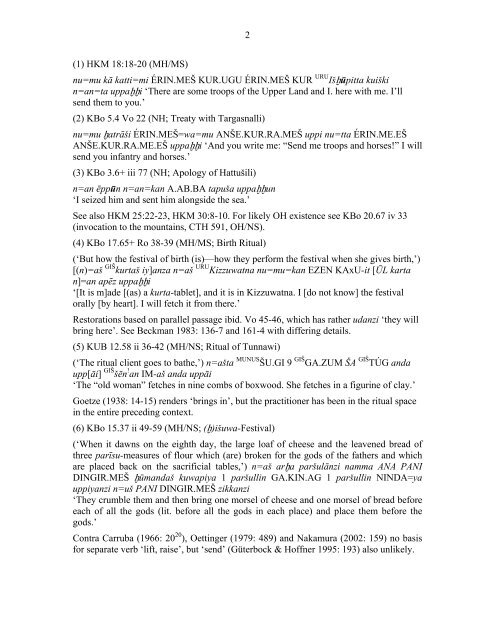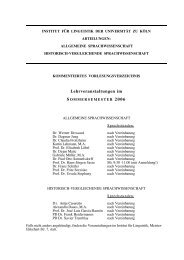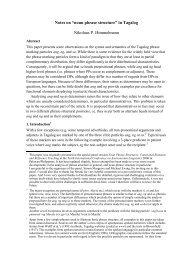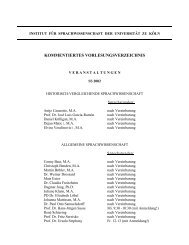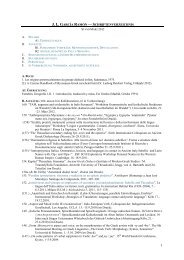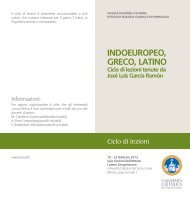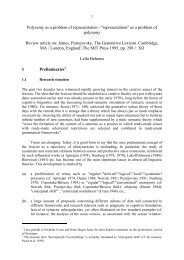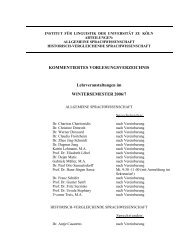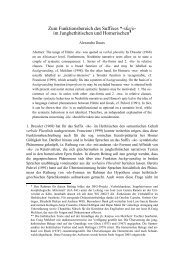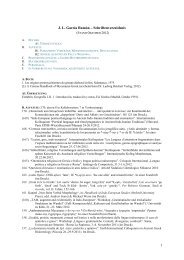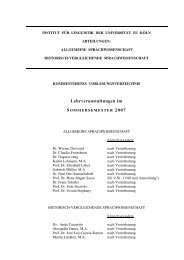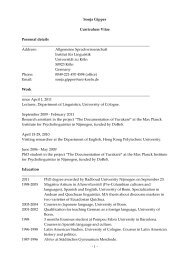Topics in Anatolian Historical Grammar Prof. Dr. H. Craig Melchert
Topics in Anatolian Historical Grammar Prof. Dr. H. Craig Melchert
Topics in Anatolian Historical Grammar Prof. Dr. H. Craig Melchert
You also want an ePaper? Increase the reach of your titles
YUMPU automatically turns print PDFs into web optimized ePapers that Google loves.
2<br />
(1) HKM 18:18-20 (MH/MS)<br />
nu=mu kā katti=mi ÉRIN.MEŠ KUR.UGU ÉRIN.MEŠ KUR URU Išḫūpitta kuiški<br />
n=an=ta uppaḫḫi ‘There are some troops of the Upper Land and I. here with me. I’ll<br />
send them to you.’<br />
(2) KBo 5.4 Vo 22 (NH; Treaty with Targasnalli)<br />
nu=mu ḫatrāši ÉRIN.MEŠ=wa=mu ANŠE.KUR.RA.MEŠ uppi nu=tta ÉRIN.ME.EŠ<br />
ANŠE.KUR.RA.ME.EŠ uppaḫḫi ‘And you write me: “Send me troops and horses!” I will<br />
send you <strong>in</strong>fantry and horses.’<br />
(3) KBo 3.6+ iii 77 (NH; Apology of Hattušili)<br />
n=an ēppūn n=an=kan A.AB.BA tapuša uppaḫḫun<br />
‘I seized him and sent him alongside the sea.’<br />
See also HKM 25:22-23, HKM 30:8-10. For likely OH existence see KBo 20.67 iv 33<br />
(<strong>in</strong>vocation to the mounta<strong>in</strong>s, CTH 591, OH/NS).<br />
(4) KBo 17.65+ Ro 38-39 (MH/MS; Birth Ritual)<br />
(‘But how the festival of birth (is)—how they perform the festival when she gives birth,’)<br />
[(n)=aš GIŠ kurtaš iy]anza n=aš URU Kizzuwatna nu=mu=kan EZEN KAxU-it [ŪL karta<br />
n]=an apēz uppaḫḫi<br />
‘[It is m]ade [(as) a kurta-tablet], and it is <strong>in</strong> Kizzuwatna. I [do not know] the festival<br />
orally [by heart]. I will fetch it from there.’<br />
Restorations based on parallel passage ibid. Vo 45-46, which has rather udanzi ‘they will<br />
br<strong>in</strong>g here’. See Beckman 1983: 136-7 and 161-4 with differ<strong>in</strong>g details.<br />
(5) KUB 12.58 ii 36-42 (MH/NS; Ritual of Tunnawi)<br />
(‘The ritual client goes to bathe,’) n=ašta MUNUS ŠU.GI 9 GIŠ GA.ZUM ŠA GIŠ TÚG anda<br />
upp[āi] GIŠ šēn ! an IM-aš anda uppāi<br />
‘The “old woman” fetches <strong>in</strong> n<strong>in</strong>e combs of boxwood. She fetches <strong>in</strong> a figur<strong>in</strong>e of clay.’<br />
Goetze (1938: 14-15) renders ‘br<strong>in</strong>gs <strong>in</strong>’, but the practitioner has been <strong>in</strong> the ritual space<br />
<strong>in</strong> the entire preced<strong>in</strong>g context.<br />
(6) KBo 15.37 ii 49-59 (MH/NS; (ḫ)išuwa-Festival)<br />
(‘When it dawns on the eighth day, the large loaf of cheese and the leavened bread of<br />
three parīsu-measures of flour which (are) broken for the gods of the fathers and which<br />
are placed back on the sacrificial tables,’) n=aš arḫa paršulānzi namma ANA PANI<br />
DINGIR.MEŠ ḫūmandaš kuwapiya 1 paršull<strong>in</strong> GA.KIN.AG 1 paršull<strong>in</strong> NINDA=ya<br />
uppiyanzi n=uš PANI DINGIR.MEŠ zikkanzi<br />
‘They crumble them and then br<strong>in</strong>g one morsel of cheese and one morsel of bread before<br />
each of all the gods (lit. before all the gods <strong>in</strong> each place) and place them before the<br />
gods.’<br />
Contra Carruba (1966: 20 20 ), Oett<strong>in</strong>ger (1979: 489) and Nakamura (2002: 159) no basis<br />
for separate verb ‘lift, raise’, but ‘send’ (Güterbock & Hoffner 1995: 193) also unlikely.


